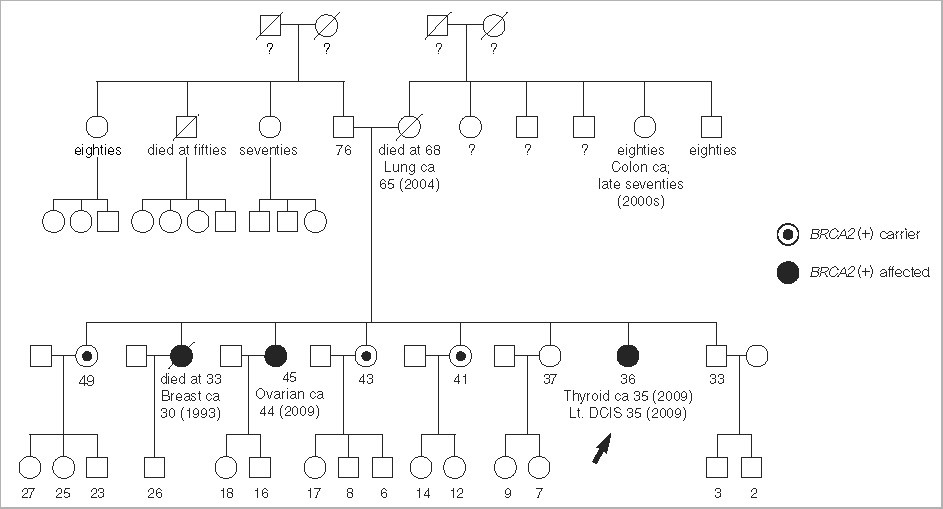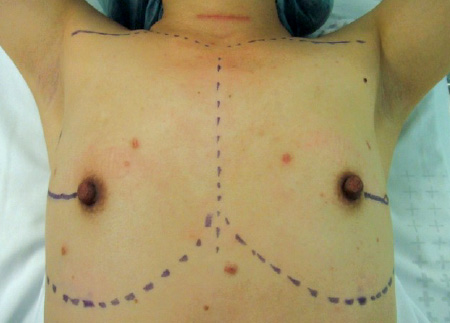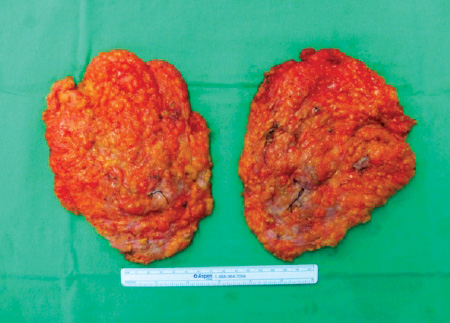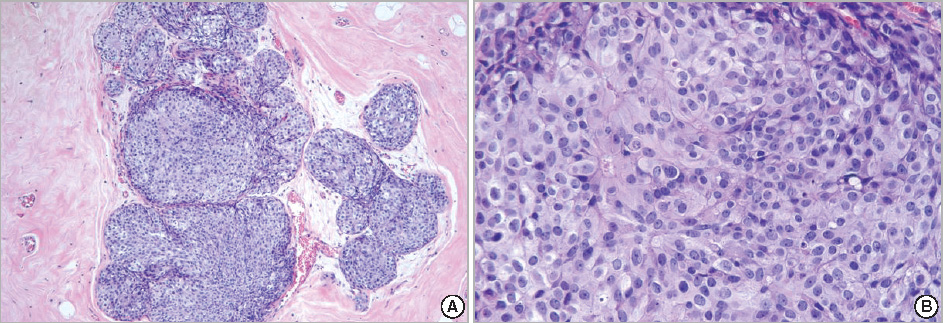J Breast Cancer.
2010 Sep;13(3):311-317.
Incidental Detection of Ductal Carcinoma In Situ of the Breast from Bilateral Prophylactic Mastectomy of Asymptomatic BRCA2 Mutation Carrier: A Case Report
- Affiliations
-
- 1Division of Breast and Endocrine Surgery, Department of Surgery, Samsung Medical Center, Sungkyunkwan University School of Medicine, Seoul, Korea. paojlus@hanmail.net
- 2Department of Surgery, Breast Care Center, Seoul National University Bundang Hospital, Seongnam, Korea.
Abstract
- In women at high-risk for breast cancer with a BRCA mutation, bilateral prophylactic mastectomy (BPM) may achieve a risk reduction. A 35-year-old woman had a strong family history of breast and ovarian cancer. She had a regular checkup and found masses in both breasts that confirmed intraductal papillomas and atypical ductal hyperplasia after vacuum assisted mass excision. When she was referred to our clinic, the genetic testing for BRCA mutation was recommended to her sister that managed for ovarian cancer. It was resulted in the positive for the BRCA2 mutation, so she had checked the genetic testing which resulted in the same as the mutation. After sufficient counseling, she decided to undergo BPM and immediate reconstruction. She is satisfied with the result of surgery. This is the first report of BPM of asymptomatic BRCA2 mutation carrier in Korea and BPM should be considered as a risk-reducing option for BRCA mutation carriers.
MeSH Terms
Figure
Reference
-
1. Finch A, Beiner M, Lubinski J, Lynch HT, Moller P, Rosen B, et al. Salpingo-oophorectomy and the risk of ovarian, fallopian tube, and peritoneal cancers in women with a BRCA1 or BRCA2 Mutation. JAMA. 2006. 296:185–192.
Article2. Narod SA, Offit K. Prevention and management of hereditary breast cancer. J Clin Oncol. 2005. 23:1656–1663.
Article3. Gahm J, Jurell G, Edsander-Nord A, Wickman M. Patient satisfaction with aesthetic outcome after bilateral prophylactic mastectomy and immediate reconstruction with implants. J Plast Reconstr Aesthet Surg. 2010. 63:332–338.
Article4. Tan MB, Bleiker EM, Menke-Pluymers MB, Van Gool AR, van Dooren S, Van Geel BN, et al. Standard psychological consultations and follow up for women at increased risk of hereditary breast cancer considering prophylactic mastectomy. Hered Cancer Clin Pract. 2009. 7:6.
Article5. Kim KS, Kim S, Han SA, Kang E, Jeon YT, Ha TH, et al. Contralateral propylactic mastectomy and prophylactic salphingo-oophorectomy in a BRCA1-positive breast cancer patient: a case report. J Breast Cancer. 2008. 11:218–222.
Article6. Hahn HM, Yeom TH, Shin YW, Kim KH, Youn DJ, Jung KJ. A standardization study of beck depression inventory in Korea. J Korean Neuropsychiatr Assoc. 1986. 25:487–502.7. Scheier MF, Carver CC, Bridges MW. Distinguishing optimism from neuroticism (and trait anxiety, self-mastery, and self-esteem): a reevaluation of the Life Orientation Test. J Pers Soc Psychol. 1994. 67:1063–1078.
Article8. Han DW, Lee CH, Tark JK. Standardization of Spielberger's anxiety test. Korean Psychological Association. accessed March 20th, 2010. http://www.koreanpsychology.or.kr.9. John EW. A community for measureing health outcomes using SF tools. SF-36 Health Survey Update. accessed March 20th, 2010. http://www.sf-36.org.10. Healey EA, Cook EF, Orav EJ, Schnitt SJ, Connolly JL, Harris JR. Contralateral breast cancer: clinical characteristics and impact on prognosis. J Clin Oncol. 1993. 11:1545–1552.
Article11. Kollias J, Ellis IO, Elston CW, Blamey RW. Clinical and histological predictors of contralateral breast cancer. Eur J Surg Oncol. 1999. 25:584–589.
Article12. Tuttle TM, Habermann EB, Grund EH, Morris TJ, Virnig BA. Increasing use of contralateral prophylactic mastectomy for breast cancer patients: a trend toward more aggressive surgical treatment. J Clin Oncol. 2007. 25:5203–5209.
Article13. Hoogerbrugge N, Bult P, de Widt-Levert LM, Beex LV, Kiemeney LA, Ligtenberg MJ, et al. High prevalence of premalignant lesions in prophylactically removed breasts from women at hereditary risk for breast cancer. J Clin Oncol. 2003. 21:41–45.
Article14. Isern AE, Loman N, Malina J, Olsson H, Ringberg A. Histopathological findings and follow-up after prophylactic mastectomy and immediate breast reconstruction in 100 women from families with hereditary breast cancer. Eur J Surg Oncol. 2008. 34:1148–1154.
Article15. Kauff ND, Brogi E, Scheuer L, Pathak DR, Borgen PI, Hudis CA, et al. Epithelial lesions in prophylactic mastectomy specimens from women with BRCA mutations. Cancer. 2003. 97:1601–1608.
Article16. Brandberg Y, Sandelin K, Erikson S, Jurell G, Liljegren A, Lindblom A, et al. Psychological reactions, quality of life, and body image after bilateral prophylactic mastectomy in women at high risk for breast cancer: a prospective 1-year follow-up study. J Clin Oncol. 2008. 26:3943–3949.
Article17. Ashikari RH, Ashikari AY, Kelemen PR, Salzberg CA. Subcutaneous mastectomy and immediate reconstruction for prevention of breast cancer for high-risk patients. Breast Cancer. 2008. 15:185–191.
Article18. Garcia-Etienne CA, CodyIii HS 3rd, Disa JJ, Cordeiro P, Sacchini V. Nipple-sparing mastectomy: initial experience at the Memorial Sloan-Kettering Cancer Center and a comprehensive review of literature. Breast J. 2009. 15:440–449.
Article19. Boughey JC, Cormier JN, Xing Y, Hunt KK, Meric-Bernstam F, Babiera GV, et al. Decision analysis to assess the efficacy of routine sentinel lymphadenectomy in patients undergoing prophylactic mastectomy. Cancer. 2007. 110:2542–2550.
Article20. Dupont EL, Kuhn MA, McCann C, Salud C, Spanton JL, Cox CE. The role of sentinel lymph node biopsy in women undergoing prophylactic mastectomy. Am J Surg. 2000. 180:274–277.
Article21. Schrag D, Kuntz KM, Garber JE, Weeks JC. Life expectancy gains from cancer prevention strategies for women with breast cancer and BRCA1 or BRCA2 mutations. JAMA. 2000. 283:617–624.
Article22. Kim KS, Kim SW, Lee MH, Ahn SH, Park SK. Korean Breast Cancer Society. Practice patterns of surgeons for the management of hereditary breast cancer in Korea. J Breast Cancer. 2008. 11:95–101.
Article
- Full Text Links
- Actions
-
Cited
- CITED
-
- Close
- Share
- Similar articles
-
- Experience with Bilateral Risk-Reducing Mastectomy for an Unaffected BRCA Mutation Carrier
- An Unusual Presentation of Extensive Ductal Carcinoma in Situ Accompanying Invasive Ductal Carcinoma on MRI: A Case Report
- Bilateral Triple-Negative Invasive Breast Cancer with a BRCA2 Mutation, and Glioblastoma: A Case Report and Literature Review
- Apocrine Ductal Carcinoma In Situ of the Breast Presented Mass with Morphological Change on Follow-Up Ultrasound: A Report of Case
- Multifocal Bilateral Breast Cancer and Breast Follicular Lymphoma: A Simple Coincidence?





